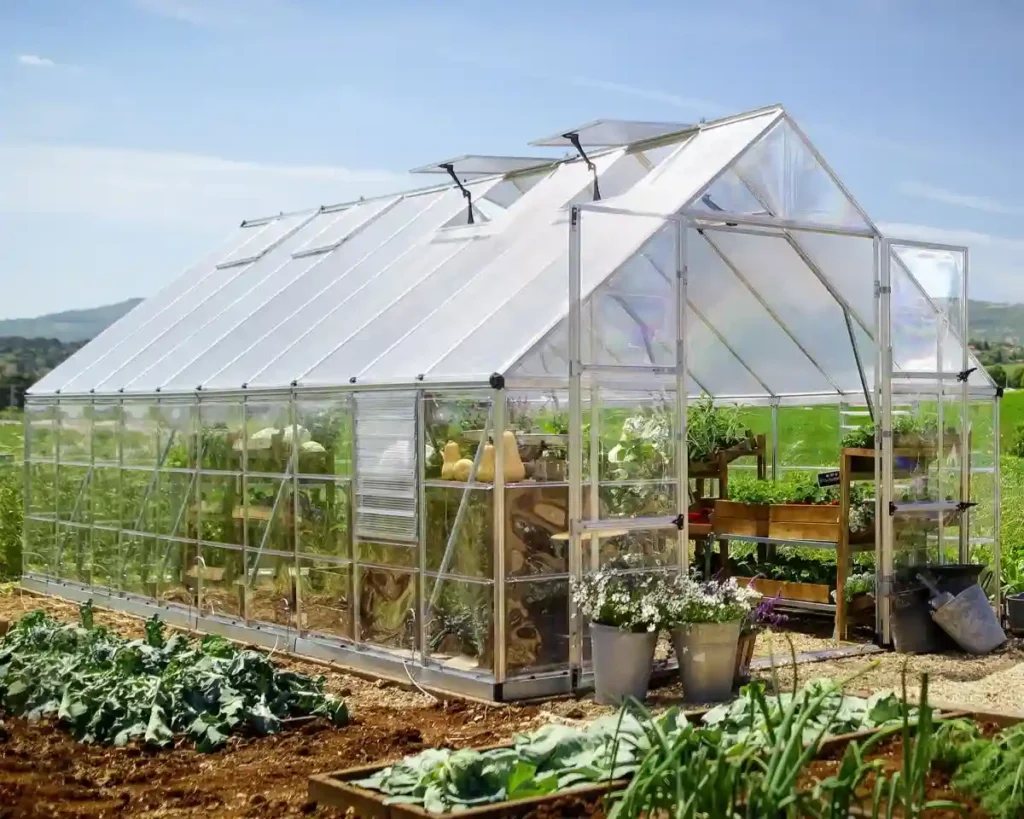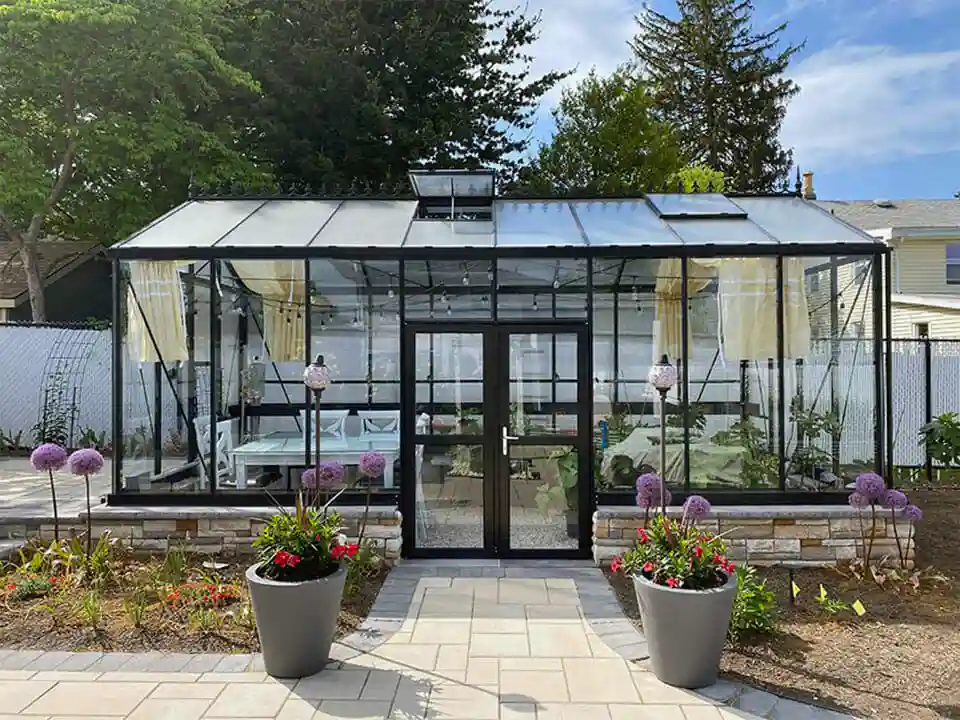Growing plants at home is fun. Greenhouse kits make it easy. You can grow food all year long. Bad weather won’t hurt your plants.
This guide tells you everything about greenhouse kits. You will learn which one is best for you.
What Are Greenhouse Kits?

Greenhouse kits come with all the parts you need. You build your own greenhouse. No need to buy parts separately.
Each kit has these parts:
- Frame pieces
- Clear walls and roof
- Screws and bolts
- Door parts
- Air vents
- Building guide
The best part is simple setup. Most people can build one in a weekend.
Types of Greenhouse Kits
Small Greenhouse Kits
Small greenhouse kits are perfect for beginners. They fit in tiny spaces.
Size is usually 3 feet by 4 feet. Some are 4 feet by 6 feet.
Why choose small greenhouse kits:
- Great for balconies
- Easy to put together
- Takes only 2 hours to build
- Costs $60 to $350
- Perfect for herbs
- Good for starting seeds
Big Greenhouse Kits
Big greenhouse kits let you walk inside. You have lots of room for plants.
Sizes start at 6 feet by 8 feet. Large ones are 12 feet by 20 feet.
Benefits of big greenhouse kits:
- Room to walk around
- Grow many different plants
- Better air flow
- Perfect for serious gardeners
- Can grow tall plants
- Costs $900 to $6000
Wall Greenhouse Kits
Wall greenhouse kits attach to your house. They use your wall as one side.
This saves space and money.
Good things about wall greenhouse kits:
- Takes less space
- Costs less money
- Easy to reach from inside
- Stays warmer in winter
- Perfect for narrow yards
- Simple to build
Curved Roof Greenhouse Kits
These greenhouse kits have curved tops. They look nice and work great.
Snow slides off easily. Rain runs off fast.
Why curved roof greenhouse kits are good:
- Very strong design
- Handles snow well
- Looks beautiful
- Water drains fast
- More head room inside
- Many sizes available
Tunnel Greenhouse Kits
Tunnel greenhouse kits are the cheapest option. They use curved metal hoops.
Plastic covers the hoops. Simple but effective.
Tunnel greenhouse kit features:
- Very cheap to buy
- Quick to set up
- Use for one season
- Great for vegetables
- Easy to move
- Costs $120 to $900
Materials for Greenhouse Kits

Frame Materials
The frame holds your greenhouse together. Different materials work better for different needs.
Metal Frames:
- Light but strong
- Never rust
- Easy to put together
- Last a long time
- Most popular choice
- Can recycle when done
Wood Frames:
- Keep heat in well
- Look very nice
- Easy to change later
- Need paint every few years
- Cost more than metal
- Bugs might eat them
Steel Frames:
- Super strong
- Good for big greenhouses
- Very heavy
- Need rust protection
- Hard to move
- Most expensive choice
Cover Materials
The cover lets light in. It keeps wind and rain out.
Glass Covers:
- Best light gets through
- Looks professional
- Lasts many years
- Easy to clean
- See plants clearly
- Costs the most money
- Can break if hit
Plastic Panel Covers:
- Strong and safe
- Light weight
- Good heat keeper
- Spreads light evenly
- 250 times stronger than glass
- Different thicknesses available
- Easy to replace
Plastic Film Covers:
- Cheapest option
- Easy to put on
- Very light
- Good light comes through
- Lasts 3 to 5 years
- Can tear easily
Clear Hard Plastic:
- Clear like glass
- Lighter than glass
- Doesn’t break easy
- Good light comes through
- Costs more than panels
- Scratches easily
Why Use Greenhouse Kits?
Grow Plants All Year
Greenhouse kits let you garden every month. Weather doesn’t matter.
You can:
- Start seeds early in spring
- Keep growing in fall
- Grow summer plants in winter
- Protect from frost
- Control heat and cold
Save Money
Greenhouse kits help you spend less on food:
- Buy fewer vegetables at store
- Don’t need to buy plants
- No gas money to garden store
- Less food goes bad
- Save money for many years
Healthier Plants
Greenhouse kits make plants grow better:
- Bugs can’t get in
- Right amount of water
- Perfect temperature
- No bad weather damage
- Less need for bug spray
- Stronger roots grow
Easy to Use
Having your own greenhouse is convenient:
- Fresh food right outside
- Garden any time of year
- No waiting for good weather
- Easy to reach plants
- Feel good about growing food
How to Pick the Right Greenhouse Kit
Check Your Space
Look at where you want to put your greenhouse kits:
- Measure the area twice
- Think about getting bigger later
- Check city rules first
- Make sure sun shines there
- Water needs to drain away
- Leave room to walk around
Think About Money
Greenhouse kits cost different amounts:
What affects the price:
- How big it is
- What it’s made of
- What comes with it
- How you pay for it
- Extra things you need
- Insurance costs
Small ones cost $60 to $400. Medium ones cost $400 to $2000. Big ones cost $2000 to $8000.
What Will You Grow?
Different greenhouse kits work for different plants:
- How many plants you want
- What kind of food you like
- How much you know about gardening
- How much time you have
- Use just in summer or all year
- Growing for fun or business
Check Your Weather
Your weather affects which greenhouse kits work best:
- How much snow you get
- How strong winds blow
- How hot and cold it gets
- How wet it is
- What storms happen
- Natural disaster risks
Building Your Greenhouse Kit
Get Ready First
Good preparation makes building easier:
Prepare the Ground:
- Make the ground flat
- Remove grass and weeds
- Make sure water drains
- Build a foundation if needed
- Check for buried wires
- Get power and water close
Tools You Need:
- Screwdrivers and wrenches
- Electric drill
- Level to check straight
- Tape measure
- Safety gloves and glasses
- Someone to help you
Foundation Choices
Greenhouse kits need solid bases:
Concrete Base:
- Strongest option
- Holds greenhouse tight
- Never moves or settles
- Costs more money
- Hard to do yourself
- Lasts forever
Wood Base:
- Cheaper than concrete
- You can do it yourself
- Works well for most
- Needs new paint sometimes
- Might rot over time
- Good for most people
Gravel Base:
- Costs the least
- Water drains through
- Easy to put in
- Might shift around
- Good for temporary use
- Easy to fix later
How to Build
Most greenhouse kits go together the same way:
1: Put in Foundation
- Make ground flat and level
- Build your chosen base
- Check water drains right
- Make sure corners are square
- Let concrete dry if used
2: Build the Frame
- Lay out all parts
- Read directions carefully
- Start with bottom frame
- Add walls one by one
- Put in door frame
3: Add the Roof
- Attach roof supports
- Put roof panels on carefully
- Make sure they overlap right
- Add air vents
- Check for leaks
4: Put on Covering
- Handle panels gently
- Follow exact instructions
- Make sure seals are tight
- Install door and vents
- Test that everything works
Common Mistakes
Don’t make these errors with greenhouse kits:
- Going too fast
- Not reading directions
- Poor ground preparation
- Bad foundation work
- Panels not lined up right
- Missing screws or bolts
- Not sealing joints well
Taking Care of Your Greenhouse
Daily Tasks
Check your greenhouse every day:
- Look at temperature
- See if plants need water
- Open or close vents
- Remove dead plants
- Watch for bugs
Weekly Jobs
Do these things each week:
- Clean inside surfaces
- Check all connections
- Fix plant supports
- Make sure equipment works
- Plan what to do next
Monthly Work
Once a month do these jobs:
- Deep clean all panels
- Check and tighten bolts
- Service heaters and fans
- Check drainage works
- Write down what you learned
Seasonal Preparation
Get ready for weather changes:
- Set up heaters for winter
- Add insulation when cold
- Fix any air leaks
- Take off summer shade
- Check all systems work
- Buy supplies for next season
Cleaning Your Greenhouse
Keep your greenhouse clean:
Supplies Needed:
- Soap and water
- Soft brushes
- Garden hose
- Disinfectant spray
- Algae cleaner
How to Clean:
- Take out all plants
- Sweep out dirt and leaves
- Wash all surfaces well
- Spray disinfectant if needed
- Let dry completely
Winter Care
Get your greenhouse ready for cold weather:
- Put in heaters if needed
- Add extra insulation
- Seal any gaps
- Remove summer shading
- Check vents work right
- Stock up on winter supplies
Cost of Greenhouse Kits
What You Pay First
Greenhouse kits cost different amounts:
Price Ranges:
- Tiny kits: $60 – $350
- Small walk-in: $350 – $1600
- Medium size: $1600 – $4000
- Large professional: $4000 – $12000
- Custom built: $12000 and up
Extra Costs
You might need to pay for more things:
Foundation Costs:
- Concrete: $4 – $7 per square foot
- Wood: $1 – $3 per square foot
- Gravel: $1 – $2 per square foot
Equipment You Might Want:
- Heaters: $250 – $1800
- Fans: $180 – $900
- Automatic watering: $120 – $600
- Shelves and tables: $250 – $1200
- Growing supplies: $120 – $600 each year
Money You Save
Greenhouse kits save you money:
Ways You Save:
- Spend less at grocery store
- Better quality food
- Grow expensive specialty crops
- Sell plants to neighbors
- House worth more money
Other Good Things:
- Family eats healthier
- Kids learn about plants
- Less stress from gardening
- Always have fresh food
- Help the environment
Popular Greenhouse Kit Brands
Top Companies
These companies make good greenhouse kits:
Palram:
- Many sizes to choose from
- Specialize in plastic panels
- Good warranty included
- Easy to put together
- Fair prices
Exaco:
- Very high quality
- Made in Europe
- Costs more money
- Great customer help
- Excellent materials
ShelterLogic:
- Good prices
- Easy to build
- Perfect for beginners
- Some you can move
- Widely available
How to Choose Good Brands
When picking greenhouse kits, think about:
- How long company has been around
- What warranty they give
- How they help customers
- Can you get replacement parts
- Are directions easy to follow
- What other customers say
Fixing Common Problems
Structure Issues
Foundation Problems:
- Check if ground has settled
- Add support where needed
- Make level again if needed
- Fix drainage around greenhouse
Frame Damage:
- Look for bent parts
- Replace broken pieces fast
- Check connections often
- Tighten loose bolts
Cover Problems
Panel Damage:
- Replace cracked panels
- Check seals are tight
- Clean often to prevent damage
- Protect from things hitting it
Too Much Moisture:
- Open vents more
- Add fans for air movement
- Watch humidity levels
- Make sure water drains out
Temperature Issues
Temperature Goes Up and Down:
- Check thermostat works right
- Add insulation where needed
- Put in thermal mass for stability
- Fix heaters and coolers
Air Flow Problems:
- Clean vents and fans often
- Remove anything blocking air
- Change settings for seasons
- Replace worn out parts
New Trends in Greenhouse Kits
Smart Technology
New greenhouse kits include:
- Automatic climate control
- Phone apps to monitor
- Sensors for watering
- LED grow lights
- Check from anywhere
Earth-Friendly Materials
Companies now use:
- Recycled materials
- Energy-saving designs
- Solar power systems
- Water-saving systems
- Natural growing methods
Flexible Designs
New greenhouse kits offer:
- Can make bigger later
- Parts you can change
- Easy to rearrange
- Change for different seasons
- Use for many purposes
Conclusion Summary
Greenhouse kits enable year-round plant growing and weather protection. Multiple types exist for different spaces and budgets. Small kits cost $60-$350, while large ones range $4000-$12000. Success requires choosing appropriate greenhouse, proper installation, and regular maintenance. Quality kits provide long-term savings on groceries and healthier family nutrition. Start planning today for fresh vegetables and herbs throughout all seasons.






